The Strychnos genre is known universally for its numerous toxic species which contain a violent poison: strychnine; hence, for that reason, it is called “vomit”. Introduced in Europe from Asia in the 16th century, these plants served as “poison tests” in trials by ordeal, likewise, to destroy undesirable rodents (this poison now banned in France since 1999), a tool featured in the crime novels of the famed author Agatha Christie, and also for doping athletes since the beginning of the 20th century. But one is familiar with the ancient principle of the pharmacopoeias: “All is poison, nothing is poison, it is all in the dose”, and strychnine is revealed as being a valuable medication in illnesses of the nervous system.
At least two species of this genre are known in Laos: Strychnos nux-vomica, without doubt, introduced from India, and Strychnos nux-blanda, spontaneous in the Indo-China peninsula.
One can find this tree of medium height in the deteriorated forests of southern Laos. Its large, twisted branches are covered with a thin, dark grey bark; its leaves are simple, oval, opposite, and tough; its little white or yellow flowers form tassels. Its green, bulging fruit, the size of an apple, turns to orange when ripe, and has a thin, rigid skin; it contains round, flat seeds in a white, somewhat viscous, pulp.
The Lao language emphasizes the danger of this plant: seng beua, “seng”, the generic for a certain number of plants and “beua”, poison. Traditionally, it is used in very small doses to fight the onset of fever, but also as an aphrodisiac, a tonic, and in cases of epilepsy.
Above all, it is the seeds which are traditionally used in today’s pharmaceutical industry; they contain different alkaloids, the principal of which is strychnine, but also brucine and others. The seeds are extracted when the fruit is ripe, at the end of the dry season; they are washed (in the past, using rice water), dried, and sold on-site or exported. The vomit nut is, in effect, on the list of NTFP (Non-timber forest products) which are exported from Laos and which contribute to the improvement of the quality of life in rural communities.
Le genre Strychnos est universellement connu pour plusieurs espèces très toxiques qui renferment un poison violent : la strychnine et que l’on nomme pour cette raison « vomiquier ». Introduit d’Asie en Europe dès le XVI siècle, ces plantes ont servi de « poison d’épreuve » dans les ordalies, puis de destructeur de rongeurs indésirables (interdit en France depuis 1999), d’outil des romans policiers de la fameuse Agatha Christie et même de dopant des sportifs du début du XX siècle. Pourtant, l’on connaît bien le vieux principe des pharmacopées : « Tout est poison, rien n’est poison, tout est dans la dose » et la strychnine s’est révélée un précieux médicament dans les maladies du système nerveux.
Au moins deux espèces du genre sont connues au Laos : Strychnos nux-vomica, sans doute introduite d’Inde et Strychnos nux-blanda, spontanée dans la Péninsule.
On rencontre cet arbre de taille moyenne dans les forêts dégradées du Sud Laos. Ses grosses branches tortueuses sont couvertes d’une fine écorce gris foncé ; ses feuilles sont simples, ovales, opposées, coriaces ; ses petites fleurs blanches ou jaunes forment des panicules. Le fruit de la taille d’une pomme est globuleux, vert puis orange à maturité, avec une fine écore rigide ; il contient des graines rondes et plates dans une pulpe blanche un peu visqueuse.
La langue lao souligne bien la dangerosité de cette plante : seng beua, « seng », générique d’un certain nombre de végétaux et « beua », poison. Traditionnellement elle est employée à très petite dose contre les accès de fièvre, mais aussi comme aphrodisiaque, tonique, et en cas d’épilepsie.
Ce sont surtout les graines qui sont employées traditionnellement et dans l’industrie pharmaceutique moderne ; elles contiennent en effet différents alcaloïdes dont le principal est la strychnine, mais aussi la brucine et bien d’autres. Les graines sont extraites quand le fruit est mûr, à la fin de la saison sèche ; elles sont lavées (autrefois dans de l’eau de riz), séchées et vendues sur place ou exportées. La noix vomique fait en effet partie des NTFP (produits de la forêt autres que le bois) qu’exporte le Laos et qui contribuent à l’amélioration du niveau de vie des populations rurales.
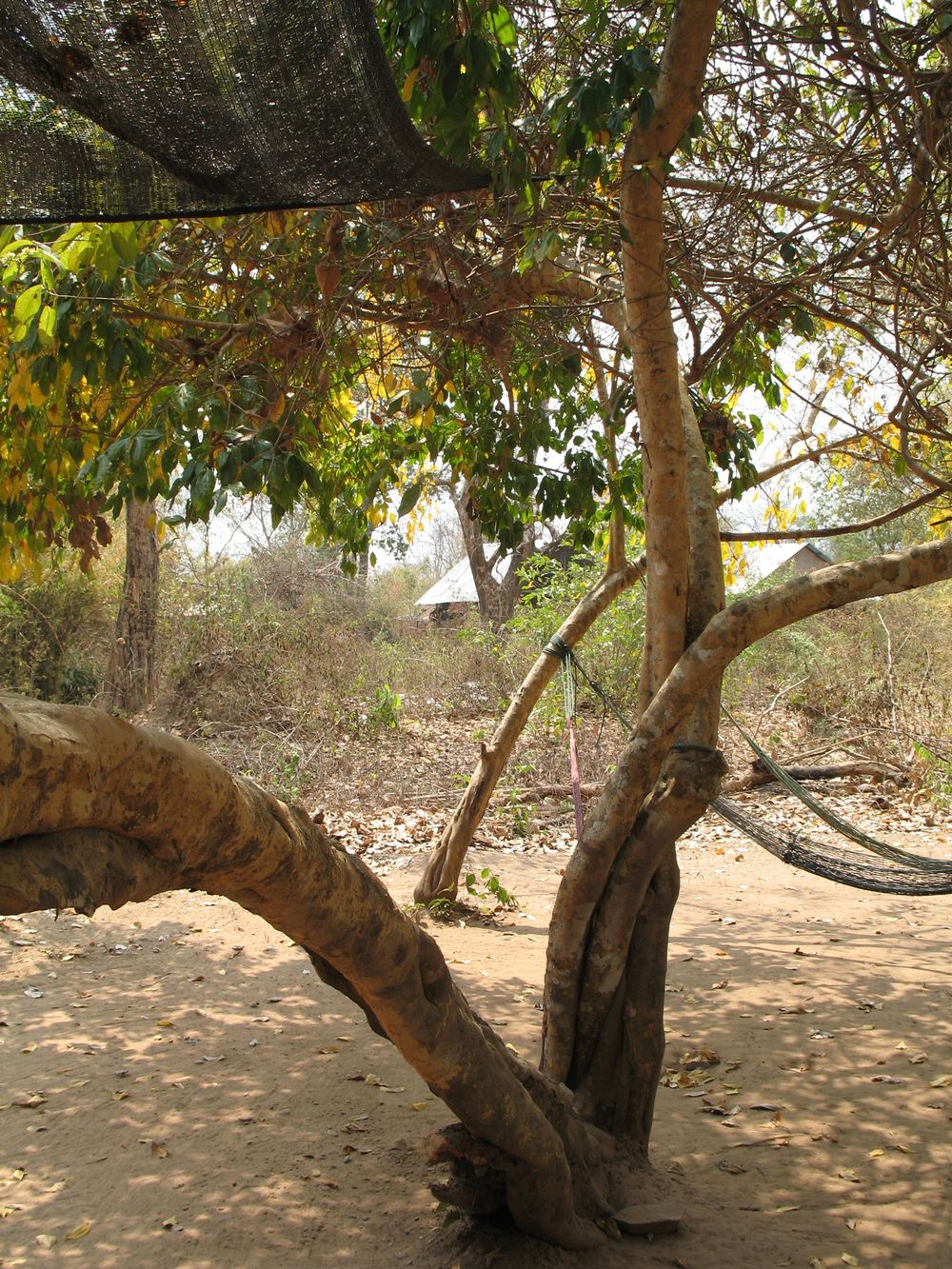
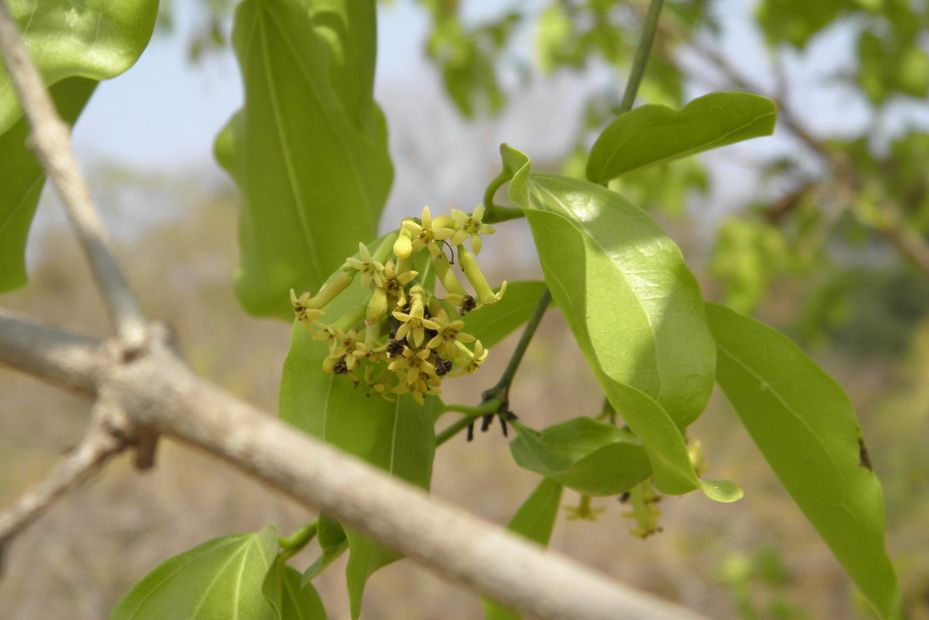
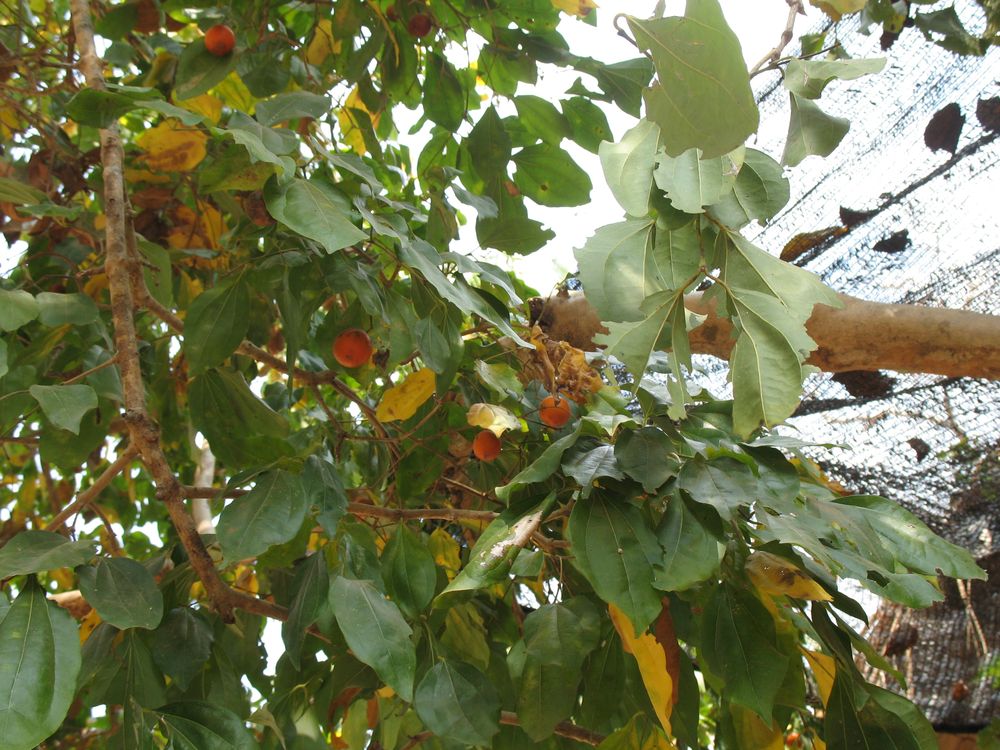
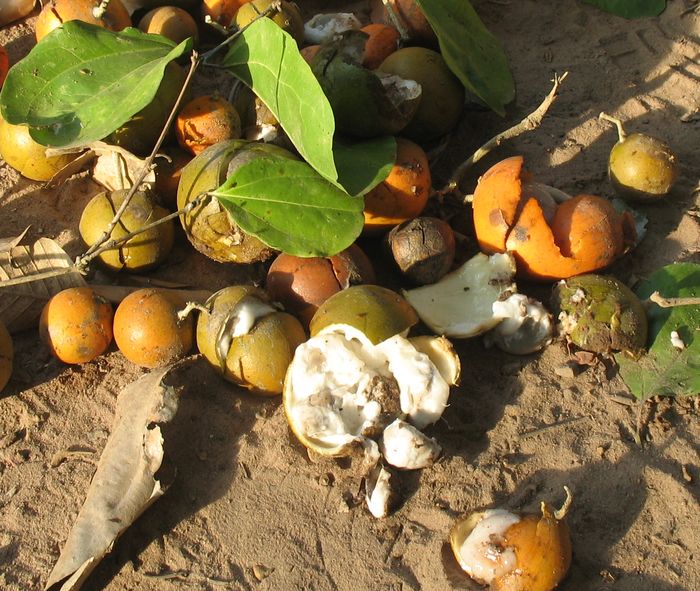
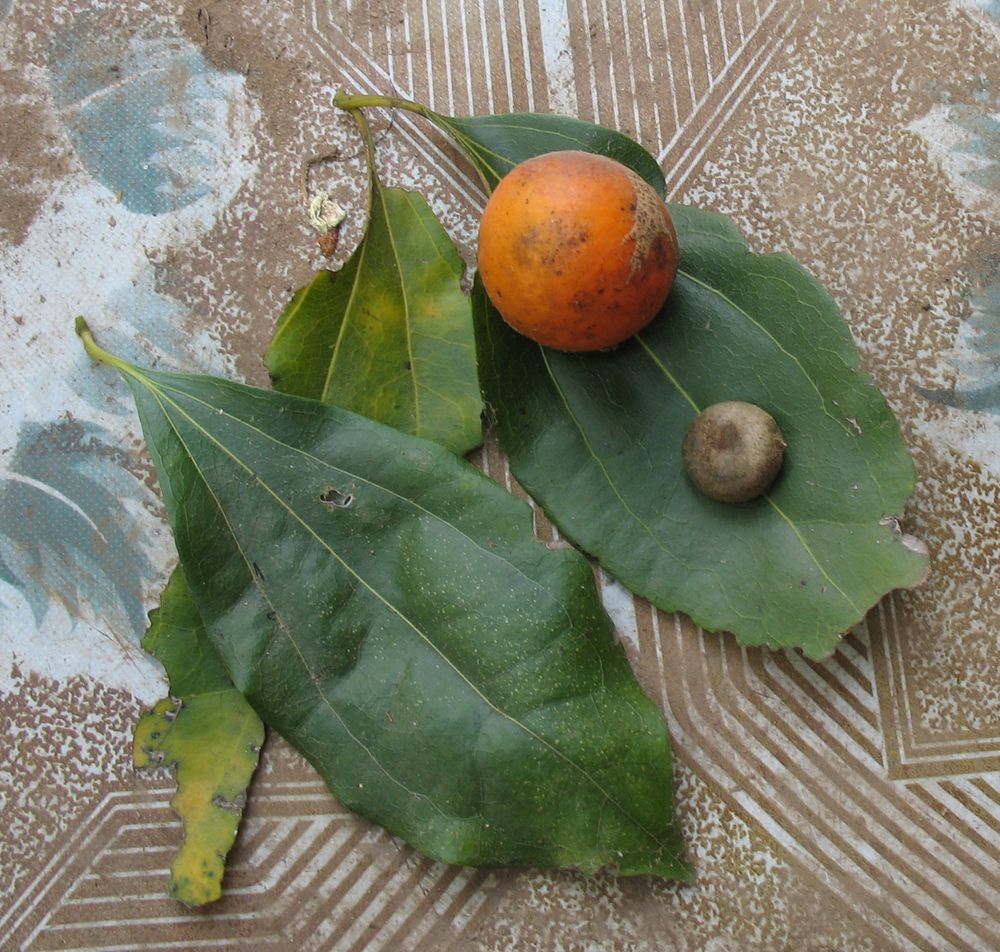
The Strychnos genre is known universally for its numerous toxic species which contain a violent poison: strychnine; hence, for that reason, it is called “vomit”. Introduced in Europe from Asia in the 16th century, these plants served as “poison tests” in trials by ordeal, likewise, to destroy undesirable rodents (this poison now banned in France since 1999), a tool featured in the crime novels of the famed author Agatha Christie, and also for doping athletes since the beginning of the 20th century. But one is familiar with the ancient principle of the pharmacopoeias: “All is poison, nothing is poison, it is all in the dose”, and strychnine is revealed as being a valuable medication in illnesses of the nervous system.
At least two species of this genre are known in Laos: Strychnos nux-vomica, without doubt, introduced from India, and Strychnos nux-blanda, spontaneous in the Indo-China peninsula.
One can find this tree of medium height in the deteriorated forests of southern Laos. Its large, twisted branches are covered with a thin, dark grey bark; its leaves are simple, oval, opposite, and tough; its little white or yellow flowers form tassels. Its green, bulging fruit, the size of an apple, turns to orange when ripe, and has a thin, rigid skin; it contains round, flat seeds in a white, somewhat viscous, pulp.
The Lao language emphasizes the danger of this plant: seng beua, “seng”, the generic for a certain number of plants and “beua”, poison. Traditionally, it is used in very small doses to fight the onset of fever, but also as an aphrodisiac, a tonic, and in cases of epilepsy.
Above all, it is the seeds which are traditionally used in today’s pharmaceutical industry; they contain different alkaloids, the principal of which is strychnine, but also brucine and others. The seeds are extracted when the fruit is ripe, at the end of the dry season; they are washed (in the past, using rice water), dried, and sold on-site or exported. The vomit nut is, in effect, on the list of NTFP (Non-timber forest products) which are exported from Laos and which contribute to the improvement of the quality of life in rural communities.
Le genre Strychnos est universellement connu pour plusieurs espèces très toxiques qui renferment un poison violent : la strychnine et que l’on nomme pour cette raison « vomiquier ». Introduit d’Asie en Europe dès le XVI siècle, ces plantes ont servi de « poison d’épreuve » dans les ordalies, puis de destructeur de rongeurs indésirables (interdit en France depuis 1999), d’outil des romans policiers de la fameuse Agatha Christie et même de dopant des sportifs du début du XX siècle. Pourtant, l’on connaît bien le vieux principe des pharmacopées : « Tout est poison, rien n’est poison, tout est dans la dose » et la strychnine s’est révélée un précieux médicament dans les maladies du système nerveux.
Au moins deux espèces du genre sont connues au Laos : Strychnos nux-vomica, sans doute introduite d’Inde et Strychnos nux-blanda, spontanée dans la Péninsule.
On rencontre cet arbre de taille moyenne dans les forêts dégradées du Sud Laos. Ses grosses branches tortueuses sont couvertes d’une fine écorce gris foncé ; ses feuilles sont simples, ovales, opposées, coriaces ; ses petites fleurs blanches ou jaunes forment des panicules. Le fruit de la taille d’une pomme est globuleux, vert puis orange à maturité, avec une fine écore rigide ; il contient des graines rondes et plates dans une pulpe blanche un peu visqueuse.
La langue lao souligne bien la dangerosité de cette plante : seng beua, « seng », générique d’un certain nombre de végétaux et « beua », poison. Traditionnellement elle est employée à très petite dose contre les accès de fièvre, mais aussi comme aphrodisiaque, tonique, et en cas d’épilepsie.
Ce sont surtout les graines qui sont employées traditionnellement et dans l’industrie pharmaceutique moderne ; elles contiennent en effet différents alcaloïdes dont le principal est la strychnine, mais aussi la brucine et bien d’autres. Les graines sont extraites quand le fruit est mûr, à la fin de la saison sèche ; elles sont lavées (autrefois dans de l’eau de riz), séchées et vendues sur place ou exportées. La noix vomique fait en effet partie des NTFP (produits de la forêt autres que le bois) qu’exporte le Laos et qui contribuent à l’amélioration du niveau de vie des populations rurales.










The Strychnos genre is known universally for its numerous toxic species which contain a violent poison: strychnine; hence, for that reason, it is called “vomit”. Introduced in Europe from Asia in the 16th century, these plants served as “poison tests” in trials by ordeal, likewise, to destroy undesirable rodents (this poison now banned in France since 1999), a tool featured in the crime novels of the famed author Agatha Christie, and also for doping athletes since the beginning of the 20th century. But one is familiar with the ancient principle of the pharmacopoeias: “All is poison, nothing is poison, it is all in the dose”, and strychnine is revealed as being a valuable medication in illnesses of the nervous system.
At least two species of this genre are known in Laos: Strychnos nux-vomica, without doubt, introduced from India, and Strychnos nux-blanda, spontaneous in the Indo-China peninsula.
One can find this tree of medium height in the deteriorated forests of southern Laos. Its large, twisted branches are covered with a thin, dark grey bark; its leaves are simple, oval, opposite, and tough; its little white or yellow flowers form tassels. Its green, bulging fruit, the size of an apple, turns to orange when ripe, and has a thin, rigid skin; it contains round, flat seeds in a white, somewhat viscous, pulp.
The Lao language emphasizes the danger of this plant: seng beua, “seng”, the generic for a certain number of plants and “beua”, poison. Traditionally, it is used in very small doses to fight the onset of fever, but also as an aphrodisiac, a tonic, and in cases of epilepsy.
Above all, it is the seeds which are traditionally used in today’s pharmaceutical industry; they contain different alkaloids, the principal of which is strychnine, but also brucine and others. The seeds are extracted when the fruit is ripe, at the end of the dry season; they are washed (in the past, using rice water), dried, and sold on-site or exported. The vomit nut is, in effect, on the list of NTFP (Non-timber forest products) which are exported from Laos and which contribute to the improvement of the quality of life in rural communities.
Le genre Strychnos est universellement connu pour plusieurs espèces très toxiques qui renferment un poison violent : la strychnine et que l’on nomme pour cette raison « vomiquier ». Introduit d’Asie en Europe dès le XVI siècle, ces plantes ont servi de « poison d’épreuve » dans les ordalies, puis de destructeur de rongeurs indésirables (interdit en France depuis 1999), d’outil des romans policiers de la fameuse Agatha Christie et même de dopant des sportifs du début du XX siècle. Pourtant, l’on connaît bien le vieux principe des pharmacopées : « Tout est poison, rien n’est poison, tout est dans la dose » et la strychnine s’est révélée un précieux médicament dans les maladies du système nerveux.
Au moins deux espèces du genre sont connues au Laos : Strychnos nux-vomica, sans doute introduite d’Inde et Strychnos nux-blanda, spontanée dans la Péninsule.
On rencontre cet arbre de taille moyenne dans les forêts dégradées du Sud Laos. Ses grosses branches tortueuses sont couvertes d’une fine écorce gris foncé ; ses feuilles sont simples, ovales, opposées, coriaces ; ses petites fleurs blanches ou jaunes forment des panicules. Le fruit de la taille d’une pomme est globuleux, vert puis orange à maturité, avec une fine écore rigide ; il contient des graines rondes et plates dans une pulpe blanche un peu visqueuse.
La langue lao souligne bien la dangerosité de cette plante : seng beua, « seng », générique d’un certain nombre de végétaux et « beua », poison. Traditionnellement elle est employée à très petite dose contre les accès de fièvre, mais aussi comme aphrodisiaque, tonique, et en cas d’épilepsie.
Ce sont surtout les graines qui sont employées traditionnellement et dans l’industrie pharmaceutique moderne ; elles contiennent en effet différents alcaloïdes dont le principal est la strychnine, mais aussi la brucine et bien d’autres. Les graines sont extraites quand le fruit est mûr, à la fin de la saison sèche ; elles sont lavées (autrefois dans de l’eau de riz), séchées et vendues sur place ou exportées. La noix vomique fait en effet partie des NTFP (produits de la forêt autres que le bois) qu’exporte le Laos et qui contribuent à l’amélioration du niveau de vie des populations rurales.


